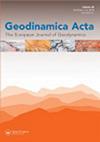Karliova三重交界周围上新世-第四纪断裂的力学:对安纳托利亚-朔尔勒东部变形的启示
IF 1.5
Q1 Earth and Planetary Sciences
引用次数: 6
摘要
欧亚和阿拉伯板块的交汇与较小的安纳托利亚Scholle板块在土耳其东部形成了Karlıova三重交汇(KTJ)。在这项研究中,我们提出了该地区的模拟模型实验,并将结果与我们的野外观测和遥感图像数据进行了比较。对比表明,KTJ西侧曲线断裂沿走向远离主位移带,从走滑到斜正滑再到纯正滑,滑感发生变化。虽然活动Prandtl单元模式已被用来解释安纳托利亚Scholle东部的整体区域断裂模式,通过对Karlıova楔内次级断层的图视图取向和模拟模拟结果的分析,认为具有沿滑动线正向倾滑分量的被动楔状Prandtl单元模型不仅可以解释KTJ周围的变形模式,而且可以解释安纳托利亚东部的内部变形。此外,这些断层积累了大量的变形,导致了KTJ周围边界断层主断层分支的不规则地震行为和相对较低的地质滑动率。缩写:走滑;Karlıova三重结(KTJ);大陆变形;北安纳托利亚断裂带;东安纳托利亚断裂带(EAFZ);瓦尔托断裂带(VFZ)本文章由计算机程序翻译,如有差异,请以英文原文为准。
Mechanics of plio-quaternary faulting around the Karliova triple junction: implications for the deformation of Eastern part of the Anatolian Scholle
ABSTRACT The intersection of the Eurasian and Arabian plates and the smaller Anatolian Scholle created the Karlıova Triple Junction (KTJ) in eastern Turkey. In this study, we present analogue model experiments for this region and compare the results with our field observations and data from remote sensing imagery. Our comparison suggests that the sense of slip along curvilinear faults at the west of the KTJ changes along strike moving away from the principal displacement zones, from strike-slip to oblique normal and then to pure normal slip. Although, the active Prandtl cell model has been proposed to explain the overall regional fault pattern at eastern part of the Anatolian Scholle, the map view orientation of the secondary faults within the Karlıova wedge and performed analogue modelling results suggest that the passive wedge-shaped Prandtl cell model with a normal dip-slip component along slip lines is more appropriate in order to explain not only deformation pattern around the KTJ but also internal deformation of eastern part of the Anatolia. Moreover, these faults accumulate the significant amount of deformation that causes to the irregular earthquake behavior and the relatively lower geologic slip-rates along the main fault branch of boundary faults around the KTJ. Abbreviations: Strike-slip; Karlıova Triple Junction (KTJ); continental deformation; North Anatolian Fault Zone (NAFZ); East Anatolian Fault Zone (EAFZ);Varto Fault Zone (VFZ)
求助全文
通过发布文献求助,成功后即可免费获取论文全文。
去求助
来源期刊

Geodinamica Acta
地学-地球科学综合
CiteScore
4.50
自引率
0.00%
发文量
0
审稿时长
25 weeks
期刊介绍:
Geodinamica Acta provides an international and interdisciplinary forum for the publication of results of recent research dealing with both internal and external geodynamics. Its aims to promote discussion between the various disciplines that work on the dynamics of the lithosphere and hydrosphere. There are no constraints over themes, provided the main thrust of the paper relates to Earth''s internal and external geodynamics. The Journal encourages the submission of papers in all fields of earth sciences, such as biostratigraphy, geochemistry, geochronology and thermochronology, geohazards and their societal impacts, geomorphology, geophysics, glaciology, igneous and metamorphic petrology, magmatism, marine geology, metamorphism, mineral-deposits and energy resources, mineralogy, orogeny, palaeoclimatology, palaeoecology, paleoceanograpgy, palaeontology, petroleum geology, sedimentology, seismology and earthquakes, stratigraphy, structural geology, surface processes, tectonics (neoteoctonic, plate tectonics, seismo-tectonics, Active tectonics) and volcanism.
Geodinamica Acta publishes high quality, peer-reviewed original and timely scientific papers, comprehensive review articles on hot topics of current interest, rapid communications relating to a significant advance in the earth sciences with broad interest, and discussions of papers that have already appeared in recent issues of the journal. Book reviews are also included. Submitted papers must have international appeal and regional implications; they should present work that would be of interest to many different specialists. Geographic coverage is global and work on any part of the world is considered. The Journal also publishes thematic sets of papers on topical aspects of earth sciences or special issues of selected papers from conferences.
 求助内容:
求助内容: 应助结果提醒方式:
应助结果提醒方式:


